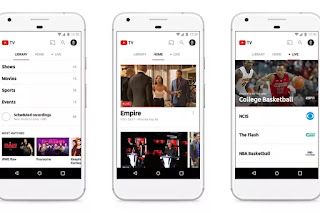GOOGLE JUST JOINED the “skinny bundle” TV war
with YouTube
TV, a paid subscription service that streams a slew of premium
broadcast and cable networks to your mobile device, tablet, computer, and
anything with Chromecast.
Just $35 a month gets you six accounts and access to
live TV from more than 40 providers including the big broadcast networks, ESPN,
regional sports networks and dozens of popular cable networks. Subscriptions
include cloud DVR with unlimited storage, AI-powered search and
personalization, and access to YouTube Red programming. YouTube CEO Susan
Wojcicki calls it the evolution of television, and a bid to “give the younger
generation the content that they love with the flexibility they expect.”
So-called skinny bundles include only those channels
you really want, at a price that is cheaper than traditional cable. They also
bring the world one step closer to the day when you can watch what you want,
when you want, when you want, on the device you want. YouTube TV joins a
growing wave of services, including Dish’s Sling TV, Sony PlayStation Vue, and
AT&T’s new
DirectTV Now, with a similar web TV offering from Hulu expected
soon. And like these other options, unfortunately, YouTube still has some
holes with its offering.
YouTube says it spent two years working on this, and
reportedly landed its first partner in October when CBS
signed on for the skinny bundle. Other big networks like ABC, NBC,
Fox, are on board, but several premium channels, like MTV and CNN, aren’t.
You can add content like Showtime and soccer for an added fee, but some content
comes with restrictions. If you’re a pro football fan, for example, you’ll have
to watch games on your TV or computer because the NFL’s deal with Verizon made
it off-limits to your mobile device. And no matter what you watch or what you
watch it on, you may see ads—Google, being Google, and its network partners can
sell ads on YouTube TV to bring in additional revenue.
The company won’t say when the service launches, but
says you can expect it in the US in the “coming weeks and months.”
Still, YouTube TV shows how far the company has come
since its founding in 2005, when it was little more than a place for people to
share homemade video clips. Today YouTube is the biggest online destination for
video, with people watching more than 1
billion hours of video each day. And if there’s one thing the
internet’s biggest video company getting into this space proves, it’s that
such a la carte viewing is the inevitable future of television.

No comments:
Post a Comment